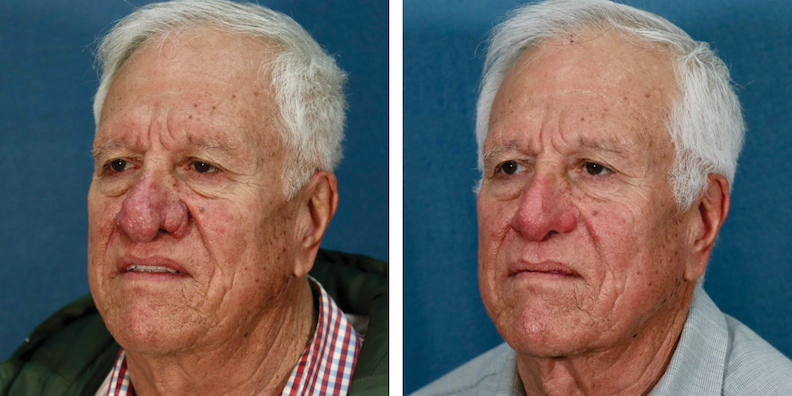Dermaplaning and Dermabrasion to Treat Rhinophyma
BACKGROUND
Rhinophyma is an uncommon form of rosacea that leads to thickening of the nasal skin and enlargement of nasal sebaceous glands. It usually occurs in men over 50. It is slowly progressive and tends to worsen over time, resulting in a bulbous shape of the nose which gradually becomes deforming. Rhinophymatous papules often form, leading to dramatic changes in the shape of the nose. It sometimes leads to nasal airway restriction, though in most cases it causes only cosmetic problems, though these can be severe. The underlying cause is unknown but is thought to be related to leakage of fluid from enlarged blood vessels resulting in inflammation and scarring. It is a clinical diagnosis and typically does not require a biopsy.

TREATMENT
Medical therapy for rhinophyma is limited, as existing deformity cannot be improved by any topical or oral treatment. Topical antibiotics and retinoids have been used to try to prevent progression but have not been shown to be consistently effective. Oral isotretinoin has shown the best evidence to prevent progression, though this is a difficult medication to prescribe for chronic use due to the requirements of the iPledge REMS system.
The most effective treatments to improve the appearance of rhinophyma are surgical, and typically involve dermaplaning (shave excision of thickened nodules) and dermabrasion (“sanding” of the skin surface manually or with a device) to sculpt the nose back into an appropriate shape. These procedures can be performed under local anesthesia, although they are bloody and may be difficult for some patients to tolerate without sedation. Appropriate protective gear including eye protection and masks should be used by everyone in the room, as dermabrasion may lead aerosolization of blood. Dermaplaning of rhinophyma is often covered by insurance, though dermabrasion for more aesthetic results may not be. Other modes of treatment employed include ablative laser and electrosurgery.
Patients must be carefully counseled preoperatively on the extended post-operative time required for healing, as surgical treatment of rhinophyma typically results in full thickness epidermal and partial thickness dermal loss of the distal nose, which must heal by secondary intent. The nose heals relatively quickly in this manner due to the high concentration of adnexal glands, but patients should expect to have an open wound, with the associated wound care involved, for 1-2 weeks. Erythema and edema of the nose will take longer to fully resolve, usually around 1 month.
After healing from dermaplaning and rhinophyma, substantial cosmetic correction is typical. Patient satisfaction with their result tends to be high.
